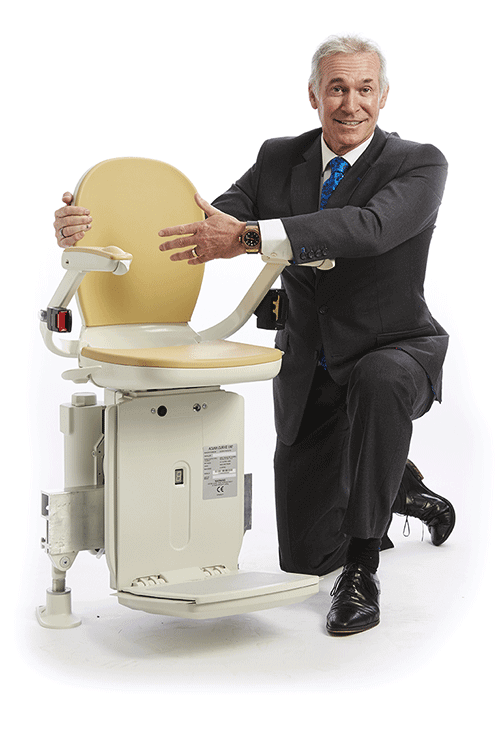Despite the common societal stigma that seniors don’t need as much sleep as younger people, this simply is not true. In fact, it is recommended that people 65 and older get between 7 and 8 hours of sleep a night.
However, researchers estimate that between 40 and 70 percent of older adults have chronic sleep issues that prevent them from getting the rest that they need, and up to half of these cases may be undiagnosed. Another study revealed that about 50 percent of people over the age of 55 have difficulty falling sleeping and maintaining a good night’s rest.
Getting a good night’s rest is essential to a high quality of life, and ageing shouldn’t have to mean sacrificing your precious sleep. Read on to learn common senior sleep issues and complaints, 7 tips for catching some more ZZs, and how an Acorn stairlift can help keep you in the home and bed you love.
Common Senior Sleep Issues and Complaints
- Insomnia
- Pain
- Nocturia (urination during the night)
- Restless Leg Syndrome
- Periodic Limb Movement Disorder
- REM Sleep Behaviour Disorder
- Sleep Apnoea
- Circadian Rhythm Sleep Disorder
- Waking up frequently during the night
- Having trouble falling asleep
- Not being able to stay asleep
- Sleeping fewer hours
- Getting less quality sleep
- Daytime drowsiness
How to Sleep Better—7 Tips for Seniors
1. Form a Consistent Bedtime Routine and Schedule.
Humans are creatures of habits by nature, so one of the most important tips for sleeping better is forming a consistent bedtime routine and schedule. When we experience bouts of insomnia that cause shifts in our sleeping patterns, our body’s natural clock is thrown off. When this happens, your body no longer knows when it is bedtime and will not react to your cues that you are ready to go to sleep, even when you are lying in bed with the lights off. This is why consistency and the creation of a sleeping schedule are essential to training your body to develop healthy habits.
While it may take time at first to get used to sleeping at a particular time, with practice and consistency, your body will eventually adapt to the new schedule. Once your body adapts to this new schedule, you will naturally start to feel sleepy around your desired bedtime, and getting a good night’s sleep will seem much easier than before.
2. Create a Relaxing Bedroom Environment, and Take Some Time to Wind Down Before Bed.
 Some people may have the envious gift of falling asleep as soon as their head hits the pillow, but for the rest of us, consistently falling asleep at a desired time is a process that requires preparation, patience, and practice. This means that our bedtime starts hours before we actually want to fall asleep. These hours leading up to bedtime should be spent winding down and preparing our bodies and minds for sleep with relaxing activities, rather than stressful, stimulating activities that keep us alert and active.
Some people may have the envious gift of falling asleep as soon as their head hits the pillow, but for the rest of us, consistently falling asleep at a desired time is a process that requires preparation, patience, and practice. This means that our bedtime starts hours before we actually want to fall asleep. These hours leading up to bedtime should be spent winding down and preparing our bodies and minds for sleep with relaxing activities, rather than stressful, stimulating activities that keep us alert and active.
Some examples of relaxing activities that could help you prepare for bedtime include taking a warm soak in a bubble bath, reading a chapter of a book, listening to soothing music, following a guided meditation, practising muscle relaxation techniques and deep breathing exercises, listening to a calm podcast, writing a journal entry about your day, etc. Do whatever it is that helps you feel relaxed. However, try to avoid activities involving electronics before bed such as your cellphone, TV, or laptop. These devices emit blue lights that can delay or reduce the body’s natural release of melatonin, thus reducing your feelings of sleepiness.
3. Turn off all Phones, Screens, and Bright Lights Before Bedtime.
Not only can electronics reduce your feelings of sleepiness before bedtime, but they can also interfere with your quality of sleep. It is important to try and keep your bedroom as dark and peaceful as possible, eliminating bright lights or sounds that can disturb your sleep cycle. If you must keep your phone beside your bed, make sure to turn down the brightness and put your phone in “do not disturb” mode.
4. Tire Your Body Out with Regular Exercise.
Exercise is beneficial for bodies of all ages and abilities, whether that means going for long walks around the park, doing strength training exercises with weights in your wheelchair, or stretching out into a flexible pose on your yoga mat. Besides the countless health benefits that regular exercise provides us with such as lowering blood pressure, maintaining a healthy weight, strengthening our heart and lungs, and much more, exercising also aids sleep.
If you choose to exercise outdoors during the day, exposure to the sun will help regulate your body’s natural clock, creating a good sleep-wake schedule. This means that your body will be more reactive to cues that it’s time to sleep such as the sun setting. Even if you exercise indoors, it will still help you sleep by tiring your body out and relieving stress and anxiety that would otherwise keep your mind racing long after the lights are out.
5. Avoid Excessive Napping and Substances that Discourage Sleep Before Bedtime.
As soon as you lose one night of quality sleep or disrupt your usual sleep schedule, your body immediately suffers the consequences. Daytime drowsiness and irritability make you want to crawl back under the cosy covers and catch up on the sleep you missed, but don’t let your beckoning bed tempt you. Napping frequently during the day only reinforces dysfunctional sleep patterns, leaving you tossing and turning when it is actually time to hit the sack.
Similarly, while it may seem more efficient to booze your way to snooze town, even small amounts of alcohol actually cause disruptions during your sleep cycle, decreasing the overall quality of your sleep. You should also avoid other substances that discourage sleep before bedtime such as caffeine, tobacco, or large meals that can cause acid reflux. Drinking a lot of fluids right before going to sleep is also not recommended, as it can cause your sleep to be interrupted by the frequent need to urinate during the night.
6. Get Cosy and Comfortable—Experiment with Mattresses, Pillows, Blankets, Temperatures, Sleeping Positions, Etc.
Consistency may be key when it comes to developing good sleeping patterns, but comfort is just as important. Mattresses, pillows, blankets, temperatures, and sleeping positions all make a huge difference when it comes to your quality of sleep. If you find that it is hard to get comfortable at night, try experimenting with different mattresses, pillows, and blankets. Depending on your preferences and how your body feels, you may need a harder, more supportive surface or a softer, more giving surface to sleep on. Trying out different fabrics for sheets, blankets, and pillowcases is also a good idea, as some fabrics or materials may cause your skin to feel irritated. If you are constantly feeling itchy at night, it is also worth looking into if you are allergic to the detergent you are using to wash your sheets.
Additionally, temperature is another important factor to consider switching up for a more satisfying night of sleep. People tend to get better quality sleep in a room with a cooler temperature, with the optimum bedroom temperature being approximately between 16 and 18 degrees Celsius for the most comfortable sleep. This is because our bodies are designed to slightly decrease in core temperature during the evening, so a colder temperature may signal to our body that we are about to sleep. Conversely, being too hot can cause more disturbances and decrease your quality of sleep.
Finally, one last important factor to consider is what sleeping position you are in when you doze off. Generally, sleeping on your side is the most utilised and recommended sleeping position, as it offers several health benefits such as promoting a healthy spinal alignment, possibly reducing snoring and heartburn, and being the position that is least likely to result in back pain. Side sleeping may also be particularly beneficial for older people, people with acid reflux, people with back pain, people who have sleep apnoea or snore, and pregnant women. However, no matter what sleeping position you choose, it is important to find one that caters to your specific needs and is comfortable for optimal sleep.
7. Speak With a Doctor About Your Concerns and Possible Solutions for Improving Sleep.
If sleeping problems still persist after trying all of the above techniques, it is time for some medical intervention, as it is possible that other factors are contributing to your sleeping difficulties such as side effects from medications, pain from medical conditions, or possibly even an undiagnosed sleeping disorder. Talk to your doctor about your sleeping complications and look into possible solutions such as switching medications, getting a prescription for sleeping pills, or having a sleep study done to diagnose a sleeping disorder.
Can’t Access Your Comfortable Bed? An Acorn Stairlift Will Send You Up the Stairs and Off to Sleep
Another issue that some seniors may face is lacking easy access to their bedrooms due to struggles with climbing stairs. However, settling for the uncomfortable couch or the unfamiliar bed can take a toll on your overall quality of sleep. After all, nothing beats drifting off to dreamland in your own bed that you know and love. Luckily, Acorn Stairlifts can help you with that.
With the addition of an Acorn stair lift to your home, you will never have to settle for the unfamiliar or uncomfortable. Like your warm and cosy bed, Acorn stairlifts are customised to fit your specific needs and home, whether that is an indoor stairlift, outdoor stairlift, curved, or straight stairlift. Installation is stress and mess-free, attaching directly to your stairs and never the wall. This means that no drilling or plastering that compromises the structure or style of your home is required.
Get in contact with Acorn Stairlifts today to claim your free, no-obligation stairlift quote and home survey. Don’t wait to regain full access to your home, independence, and mobility. Start living your life to the fullest today.

